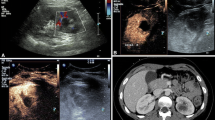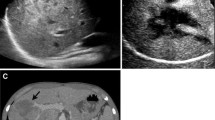Abstract
Active contrast medium extravasation is a recognized and important angiographic and computed tomographic (CT) sign of bleeding. It is an indicator of active, ongoing, and potentially life-threatening hemorrhage and, hence, of the need for an immediate surgical or interventional treatment. Sonography (US) is frequently used as the first imaging option for screening patients with traumatic and nontraumatic abdominal emergencies. Owing to the current possibilities of low-mechanical index, real-time, contrast-specific systems, it is now possible to detect a contrast leakage by using US. This finding opens new possibilities in the assessment and management of several abdominal emergencies, including trauma (initial workup and monitoring), spontaneous hematomas, and rupture of aneurysms or masses. This article describes the technique, findings, possibilities, and limitations of contrast-enhanced US in the evaluation of active abdominal bleeding.




Similar content being viewed by others
References
Harvey CJ, Blomley MJK, Eckersley RJ, et al. (2001) Developments in ultrasound contrast media. Eur Radiol 11:675–689
Lencioni R, Cioni D, Bartolozzi C (2002) Tissue harmonic and contrast-specific imaging: back to gray scale in ultrasound. Eur Radiol 12:151–165
Bauer A, Solbiati L, Wessman N (2002) Ultrasound imaging with SonoVue: low mechanical index real-time imaging. Acad Radiol 9(suppl):282–284
Catalano O, Lobianco R, Sandomenico F, et al. (2004) Real-time, contrast-enhanced sonographic imaging in emergency radiology. Radiol Med 108:454–469
Catalano O, Lobianco R, Cusati B, et al. (2005) Contrast-enhanced sonography for diagnosis of ruptured abdominal aortic aneurysm. AJR 184:423–427
Catalano O, Lobianco R, Sandomenico F, et al. (2003) Splenic trauma: evaluation with contrast-specific sonography and a second-generation contrast medium: preliminary experience. J Ultrasound Med 22:467–477
Catalano O, Nunziata A, Cusati B, et al. (2004) Real-time, contrast-specific sonography imaging of acute splenic disorders: a pictorial review. Emerg Radiol 11:15–21
Catalano O, Lobianco R, Mattace Raso M, et al. (2005) Blunt hepatic trauma: evaluation with contrast-enhanced sonography. J Ultrasound Med 24:299–310
Poletti P-A, Platon A, Becker CD, et al. (2004) Blunt abdominal trauma: does the use of a second-generation sonographic contrast agent help to detect solid organ injuries? AJR 183:1293–1301
Oldenburg A, Hohmann J, Skrok J, et al. (2004) Imaging of paediatric splenic injury with contrast-enhanced ultrasonography. Pediatr Radiol 34:351–354
Glen P, MacQuarrie J, Imrie CW, et al. (2004) A novel application of ultrasound contrast: demonstration of splenic arterial bleeding. Br J Radiol 77:333–334
Leen E, Moug SJ, Horgan P (2004) Potential impact and utilization of ultrasound contrast media. Eur Radiol 14(suppl 8):16–24
Thorelius L (2003) Contrast-enhanced ultrasound: beyond the liver. Eur Radiol 13(suppl 3):91–108
Thorelius L (2004) Contrast-enhanced ultrasound for extrahepatic lesions: preliminary experience. Eur J Radiol 51(suppl):31–38
Thorelius L (2004) Contrast-enhanced ultrasound in trauma. Eur Radiol 14(suppl 8):43–52
Morel DR, Schwieger I, Hohn L, et al. (2000) Human pharmacokinetics and safety evaluation of SonoVue™, a new contrast agent for ultrasound imaging. Invest Radiol 35:80–85
Yao DC, Jeffrey RB, Mirvis SE, et al. (2002) Using contrast-enhanced helical CT to visualize arterial extravasation after blunt abdominal trauma. AJR 178:17–20
DiGiacomo JC, McGonigal MD, Haskal ZJ, et al. (1996) Arterial bleeding diagnosed by CT in hemodynamically stable victims of blunt trauma. J Trauma 40:249–252
Fang JF, Chen RJ, Wong YC, et al. (1998) Pooling of contrast material on computed tomography mandates aggressive management of blunt hepatic injury. Am J Surg 176:315–319
Willmann JK, Roos JE, Platz A, et al. (2002) Multidetector CT: detection of active hemorrhage in patients with blunt abdominal trauma. AJR 179:437–444
Poletti P-A, Wintermark M, Schnyder P, et al. (2002) Traumatic injuries: role of imaging in the management of the polytrauma victim (conservative expectation). Eur Radiol 12:969–978
Schurr MJ, Fabian TC, Gavant M, et al. (1995) Management of blunt splenic trauma: computed tomography contrast blush predicts failure of nonoperative management. J Trauma 39:507–513
Omert LA, Salyer D, Dunham CM, et al. (2001) Implications of the “contrast blush” findings on computed tomographic scan of the spleen in trauma. J Trauma 51:272–277
Catalano O, Lobianco R, Esposito M, et al. (1999) Contrast material extravasation following upper abdominal trauma. Radiol Med 97:138–143
Ryan MF, Hamilton PA, Chu P, et al. (2004) Active extravasation of arterial contrast agent on post-traumatic abdominal computed tomography. Can Assoc Radiol J 55:160–169
Mortele KJ, Cantisani V, Brown DL, et al. (2003) Spontaneous intraperitoneal hemorrhage: imaging features. Radiol Clin North Am 41:1183–1201
Ochsner MG (2001) Factors of failure for nonoperative management of blunt liver and splenic injuries. World J Surg 25:1393–1396
Poletti PA, Mirvis SE, Shanmuganathan K, et al. (2000) CT criteria for management of blunt liver trauma: correlation with angiographic and surgical findings. Radiology 216:418–427
Goldberg BB, Merton DA, Liu J-B, et al. (1998) Evaluation of bleeding sites with a tissue-specific sonographic contrast agent: preliminary experiences in an animal model. J Ultrasound Med 17:609–616
Liu J-B, Merton DA, Goldberg BB, et al. (2000) Contrast-enhanced two- and three-dimensional sonography for evaluation of intra-abdominal hemorrhage. J Ultrasound Med 21:161–169
Schmiedl UP, Carter S, Martin RW, et al. (1999) Sonographic detection of acute parenchymal injury in an experimental porcine model of renal hemorrhage: gray-scale imaging using a sonographic contrast agent. AJR 173:1289–1294
Martegani A, Aiani L, Borghi C (2004) The use of contrast-enhanced ultrasound in large vessels. Eur Radiol 14(suppl 8):73–86
Parks RW, Chrysos E, Diamond T (1999) Management of liver trauma. Br J Surg 86:1121–1135
Uranus S, Pfeifer J (2001) Nonoperative treatment of blunt splenic injury. World J Surg 25:1405–1407
Goan YG, Huang MS, Lin JM (1998) Nonoperative management for extensive hepatic and splenic injuries with significant hemoperitoneum in adults. J Trauma 45:360–364
Napoli V, Bargellini I, Sardella SG, et al. (2004) Abdominal aortic aneurysm: contrast-enhanced US for missed endoleaks after endoluminal repair. Radiology 233:217–225
Sivit CJ (2000) Detection of active intraabdominal hemorrhage after blunt trauma: value of delayed CT scanning. Pediatr Radiol 30:99–100
Author information
Authors and Affiliations
Corresponding author
Rights and permissions
About this article
Cite this article
Catalano, O., Cusati, B., Nunziata, A. et al. Active abdominal bleeding: contrast-enhanced sonography. Abdom Imaging 31, 9–16 (2006). https://doi.org/10.1007/s00261-005-0369-6
Published:
Issue Date:
DOI: https://doi.org/10.1007/s00261-005-0369-6




